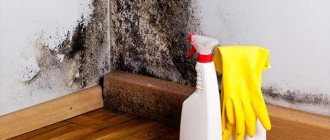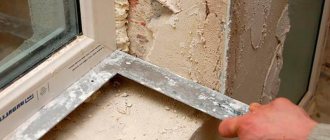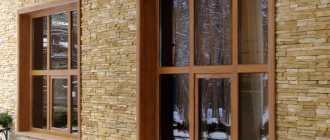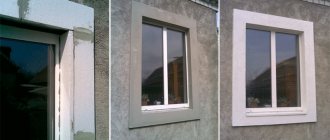Nowadays you won’t surprise anyone with installed plastic windows in your apartment. From the rank of luxury in the early 2000s, today they have become commonplace. Of course, PVC windows have quite a lot of advantages. However, in addition to the quality of the structures themselves, the final result largely depends on the correctness of their installation.
What could be the risk of installing plastic windows bypassing GOST rules? First of all, this is the sagging of the sashes and the appearance of cracks, which serve as sources of draft penetration and the formation of mold, both on the window frame and around it - on the slopes, corners of the window sill and in other places.
This article is devoted to the causes of mold, ways to neutralize it and prevent its occurrence.
What are the causes of mold on a window structure?
The main reason why mold appears on windows lies in the design of the window. The fact is that modern PVC windows are sealed, that is, when closed, unlike old Soviet ones, they do not have small cracks, which means they do not allow fresh air to pass through. As a result of this phenomenon, an increased level of humidity is formed in the room. Humidity is the factor that causes mold to form on windows.
Methods and materials for elimination
Mold on the slopes of metal-plastic windows can be removed mechanically or using chemicals.
There are several chemicals that are used when slopes turn black and mold appears:
Primer with antiseptic. It is also useful to use during finishing work to prevent the appearance of mold.- Chlorine bleaches. Any product containing chlorine destroys bacteria and fungi.
- Citric acid, boric acid or vinegar are popular means of fighting bacteria and fungi.
- Hydrogen peroxide is an excellent anti-mold remedy. Its advantage is that this drug is not dangerous to humans.
- Ammonia will help remove mold from ceramic tiles, glass or other smooth surfaces.
- A concentrated solution of baking soda will also help remove mildew from smooth surfaces. Another advantage of soda is that it is non-toxic to humans and does not damage surfaces.
- Borax is a natural material that is water soluble and can help fight fungus. There is no need to wash it off.
- Tea tree or grapefruit oil is dissolved in water and the surfaces where mold has appeared are treated with this solution.
- Potassium permanganate dissolved in water also helps in the fight against mold.
- The prepared solution: copper sulfate (100 g), bleach (100 g) and water (1 l) kills mold.
- The easiest way to remove mold on a concrete wall is mechanically using a hammer drill or spatula, removing a layer of plaster.
Features of mold.
Mold, at its core, is a microscopic fungus that reproduces under certain conditions - high humidity and temperatures above 15 degrees Celsius.
Mold fungus has the ability to destroy the structure of building materials. This biodestructor can be found especially often on the surface of concrete, brick, and wallpaper. Due to prolonged contact, the fungus changes the original structure of the infected materials and, as a result, over time, causes their destruction.
However, the main feature of mold is its harmful effects on the human body. Even the air, which contains microscopic pores of this fungus, can become a source of serious human diseases, which can even lead to death. Watch the movie "Mold" and you will learn how dangerous these microorganisms can be.
A sensational documentary from Channel One.
Prevention measures
The most important thing is to maintain a normal (for residential premises) microclimate:
- ensure the influx of fresh air and the outflow of “stagnant” air (that is, supply and exhaust ventilation must work normally);
- make sure that the window does not fog up and that condensation does not appear anywhere;
- control and maintain humidity not higher than normal (no higher than 60%, this should especially be monitored in the kitchen).
Let's take a closer look at the methods of prevention:
- Hang a hygrometer (a device that measures humidity) in every room and kitchen. In principle, if mold has never appeared, or appears, but slowly and rarely, this is not necessary: if the humidity is exceeded, then only slightly.
- Periodically (at least once a month) inspect the windows to see if mold has appeared. If yes, do not run it, but delete it in a timely manner.
If you buy windows, buy a model with micro-ventilation, or so that you can open the window like a window in several modes (with different opening angles, including a minimum for a weak draft).
If the apartment is being renovated, the slopes and walls around the window opening must be treated with any waterproofing agent, and covered only with moisture-proof plasterboard (if it is used and not plaster).
Why do you need a smoke bomb for a cellar, and how to use it correctly?
How to get rid of mold in the basement of your home: methods of control and preventive measures
Related Posts
How to prevent mold from forming on windows.
To prevent the appearance of mold fungus in potential areas of contamination of the premises, the following should be ensured:
- A ventilation system of sufficient capacity;
- Absence of sources that artificially increase normal humidity levels;
- Maintaining humidity levels at no more than 60%.
In relation to plastic windows, you need to take into account that maximum efforts must be made to eliminate the likelihood of mold even before starting work on installing light-transmitting structures.
To do this, the window opening should be cleaned of stale organic materials by treating it with a special agent designed to destroy fungus. In addition, it is necessary to pay attention to old window sills - under their bottom, in addition to dust, they accumulate an incredible amount of mold spores. If this step is ignored, an uncleaned source of infection may cause mold to form on the glass unit.
Rules to prevent mold growth
There are some points that must be observed to ensure that black streaks of mold do not appear on your windows. These rules must be followed constantly.
- Do not block the ventilation opening in the kitchen with furniture. In this room, elevated temperatures are most often observed. If you close the ventilation grille, this will impede circulation;
- Check your plastic windows at least twice a year and take care of them. It is necessary to make sure that the fittings are in good condition, sealing, and the cleanliness of the slopes and frames. If you discover a small defect or breakdown, try to seek help from a technician as quickly as possible or fix the problem yourself. It is better to carry out timely repairs and maintenance of plastic windows than to get rid of the fungus later;
- there is no need to grow indoor plants in large quantities; they also help increase the humidity in the room;
Flowers on the windowsill can cause fungus to appear on the slopes - if there are interior doors in the room, try to open them and keep them open - this also promotes air circulation;
- Ventilation is necessary. This is worth doing every day. A good option would be to have an air conditioner;
- try not to dry clothes indoors with the windows closed;
- do not forget to regularly treat the surface of windows with products that contain chlorine.
The most important companion of mold is condensation. If you notice its appearance, inspect the window frame. Pay attention to the bottom corners. If you find blackheads, you need to start fighting them. Wash them off with a special solution or treat them with bleach.
Constant fogging of the window can lead to the appearance of mold.
You can purchase an antiseptic primer and cover the areas where mold has appeared with it, leaving the treated layer for 2 days, then rinse with water.
What causes condensation to form on windows and how to deal with it.
The formation of condensation on windows can also be a reason why windows become covered with black mold. The reasons for the occurrence of condensing moisture were described in detail in the article “Why condensation forms on plastic windows.”
To briefly describe the problem, we can say that one of the reasons why water condenses on the window glass is the window sills that protrude too much forward, preventing normal air circulation in the room. Let us remind you that the installation of window sills should be done in such a way that the heating radiator is half hidden by them.
As an alternative to combat the formation of condensation, you can consider installing special humidified ventilation valves in the upper part of the window. Their task is to automatically ensure the passage of fresh air from the street.
Another solution to effectively prevent the occurrence of a mold outbreak is to install a ventilation system in the problem room, which, as a result of its operation, should facilitate the effective removal of moisture from the room. This prevents condensation from forming on the windows, and thus reduces the likelihood of mold growth to a minimum.
What to do to prevent the appearance?
The best way to combat mold, as well as disease, is prevention. Because the appearance of mold is already a fait accompli and the final part of the problem that needs to be dealt with, and its elimination is not cheap.
To prevent this from happening, you need to monitor the condition of the windows. If condensation constantly collects on the windows, this always leads to mold fungus appearing on the slopes over time.
In order to prevent the appearance of condensation on metal-plastic windows and slopes, you need to look for the causes and eliminate them.
A wide window sill covering heating radiators can interfere with the circulation of warm air and the windows will begin to fog up.
If the window sill board cannot be reduced, then holes can be drilled in it, which will facilitate the flow of warm air to the window frames, which will improve ventilation. Special grilles or blinds are installed on the window sills.They can be purchased in specialized stores, and through their holes, warm air from the batteries will be directed to the window, as a result of which the window frame will warm up and condensation will no longer appear on the frames.
- Due to the fact that plastic windows are closed hermetically, there is no ventilation in the room, therefore, the windows should be left in the ventilation position more often.
- In the kitchen, when preparing food, be sure to use the hood and open the windows to ensure good ventilation. The bathroom should also have good ventilation.
- The air temperature in the room should not exceed 22-24 °, and humidity - 60%.
- When drying clothes in an apartment, be sure to open the windows - this will prevent them from fogging up.
- Window frames and slopes should be washed with special products that prevent the appearance of fungus.
- Regular preventive inspection of working fittings, mechanisms and gaskets and their lubrication will help avoid the appearance of condensation.
- It is best to install metal-plastic windows in the warm season. Before installation, carefully treat the window opening with fungicidal agents.
- Trust installation only to trusted specialists, make sure that all cracks are carefully filled with foam, sealed with sealant, and then plastered with high quality.
- When sealing slopes, use a primer containing an antiseptic.
Fighting hotbeds of spores.
Physical methods:
- using ultraviolet irradiation;
- mechanical cleaning;
- heat treatment with dry hot air.
Chemical methods:
- Application of fungicides to treat window openings. The advantage of this method is that manufacturers of such chemicals provide certain warranties, usually five years, during which the development of mold on the material is completely excluded.
- If it is impossible to use fungicides for surface treatment, you can use products containing chlorine.
Elimination Features
To effectively remove mold from a window, you must act scrupulously, not missing even the smallest speck. It is not enough to simply clean the visible surface, because the likelihood that mold spores have spread inside the structure or onto the wall is very high. Depending on which part of the structure is affected by mold, some nuances must be taken into account during processing.
From the frame
Removing fungus on the frame of plastic windows seems simple at first glance. But upon closer examination, the matter is complicated by the presence of additional parts, seals, and corners that are difficult to clean. Algorithm of actions:
- Washing mold deposits on plastic and glass.
- Cleaning mold on glass and frames using a stiff brush.
- Warming up and drying surfaces with a construction hairdryer.
Construction hair dryer
After there are no black spots left on the double-glazed windows, the glass and frame are treated with antifungal agents.
From the slopes
If mold appears on the slopes of plastic windows, this is most likely a sign that the fungus is actively spreading under the slopes, and perhaps the process has already affected the wall under the window. The first step is to clean off the mold deposits on the window slopes. If stains appear on a plastic window sill, wash it thoroughly too. Then you will have to carry out the following manipulations:
- Disassemble the slopes, dismantle the window sill.
- Rinse the entire affected surface, clean it with sandpaper or a stiff brush, and after cleaning, treat with an antiseptic to prevent the development of fungus on the slopes and under them.
- Seal cracks and seal joints.
- Reinstall all removed parts.
To prevent the interior of the apartment from being spoiled by black slopes on the windows in the future, it is worth using a waterproofing material, for example, mastic.
What to do to remove mold from a window.
As mentioned above in the text, the appearance of mold is mainly caused by an increase in humidity in the room, which, in turn, leads to the formation of condensation on the window glass. Isolated cases of condensation droplets appearing are not so terrible. Regular condensation of moisture on the glass unit is dangerous.
Most often, mold appears at the bottom of the window, in the corners. If, when examining a light-transmitting structure, black dots characteristic of mold are encountered, then it is necessary to begin eliminating the lesion as quickly as possible, adhering to the following algorithm:
- Assess the extent of damage to the window. Remove black stains with a biocide or detergent containing bleach. As a precaution, work only with gloves on.
- If mold forms on window slopes, they must be dismantled. The voids that exist underneath are foamed with polyurethane foam, the excess of which is removed with a utility knife.
- Treat the joints and slopes (for these purposes you can use the Anti-Mold product), and only then finish them “clean”. After two days, wash the entire window with water.
- To ensure effective control of the humidity level in the room, it should be equipped with a thermometer-hygrometer. If the humidity value on the thermometer display is over 30%, at a temperature of 21 degrees Celsius, then the room should be ventilated by opening a window.
How to fight mold on the slopes of plastic windows
How to get rid of mold on plastic windows
We clean windows in the off-season, but sometimes there is a need for additional procedures. For example, if you notice that mold has begun to appear on your plastic double-glazed windows.
Of course, you need to get rid of the fungus, and then eliminate the cause of its occurrence, if possible. Today we will tell you exactly how to deal with traces of mold on plastic windows in the house, how to remove it from slopes and window sills, and what should be done.
It's better not to let the windows get into this state.
There are a number of ways to save on utility bills.
- How to legally save up to 60% water in a month .
- How to pay 2 times less for electricity .
- How to reduce gas consumption by 40% .
Input data
The use of plastic windows has long become widespread. They are convenient and practical, they do their job perfectly, they close hermetically, save us from the cold, noise from the streets, and bring comfort and coziness into the house. In addition, from an aesthetic point of view, they look much more impressive than any painted wooden frames.
By the way, there is no need to paint double-glazed windows either; they hold their color well and practically do not fade. To bring them back to normal condition, it is enough to simply wash them from time to time.
All these excellent qualities of double-glazed windows are preserved with proper installation, but if miscalculations and mistakes were made in this process, then problems may arise. The most common problem is high humidity, and as a result the formation of fungus and mold.
Unlike wooden windows, which are not so airtight because they have large gaps in their design through which moisture escapes, plastic windows close tightly, completely blocking fresh air. It is the main advantage of double-glazed windows that in this case becomes the main disadvantage, generating condensation indoors.
Double-glazed windows allow you to create a comfortable microclimate at home
A warm, humid environment is perfect for mold, so it happily takes up residence there. This microscopic fungus causes a lot of trouble and leads to the destruction of building materials. Builders call mold a biodestructor, since most construction problems result in the fight against this fungus, and it does not spare materials.
In addition, mold has a negative impact on human health. Spores of microorganisms enter the humid indoor air that we breathe, and as a result, severe allergies or other diseases, such as mycoses, can develop.
Window care
However, with normal care and constant attention, even problematic windows can be kept clean and tidy. To do this you need the following:
- constantly carry out cleaning activities to remove dust;
- install air conditioning systems in the house, check general ventilation;
- Eliminate sources of moisture and dampness in the room. distribute indoor plants around the house, dry clothes in designated areas, quickly resolve issues with pipe leaks, wash with a limited amount of water;
- excellent atmospheric indicators for the room: temperature around +22°C, humidity no more than 60%.
Note that mold from old windows can migrate to new ones, so when preparing to install double-glazed windows, it is necessary to take drastic measures to destroy the fungus.
After dismantling the old windows, it is necessary to clean the window opening, remove all traces of organic materials and dirt. Particular attention should be paid to the area under the windowsill near the radiator, a favorite place for mold. After removing the stains, it is highly recommended to treat the window opening with mold-fighting agents called fungicides. With this approach, even high humidity in the room may not lead to mold on the windows, slopes, or windowsills.
Ventilate your apartment regularly
If time is lost and mold appears, then you need to start eliminating it. A whole range of measures will help us get rid of fungus and mold for a long time, from mechanical removal to chemical treatment.
- To destroy the source of mold, you first need to physically remove the fungus, then heat treat the site of occurrence using hot air, such as a hairdryer. If you have UV irradiators lying around at home, you can additionally irradiate the fungus.
- After mechanical work, it is imperative to treat the areas where mold appears with chemicals. It is acceptable to use a chlorine-containing detergent, but it is best to use special fungicides, which we will discuss later. Treatment with such compounds will allow you to get rid of the fungus for a long time, for several years. In addition, fungicides have cleaning effects, so in addition you will remove dirt from frames, slopes, and window sills.
Among the most popular means for combating mold, the following compositions can be distinguished:
- Bleach is the simplest and cheapest remedy, in addition to fungus, it kills bacteria and disinfects space. Bleach is diluted with water in a ratio of one to five. To work with this chemical, wear gloves and a respirator. Bleach kills mold instantly, so it makes no sense to apply it for a long time. It can negatively affect the decorative component of your window, so it is better not to use it for the front parts of plastic frames, slopes, and window sills.
- Poisonous copper sulfate perfectly destroys all microorganisms. When using it, you must wear rubber gloves, and a respirator is also necessary. Copper sulfate is suitable for processing frames and slopes made of plastic; it cannot be applied to metal parts, as it causes corrosion.
- It is permissible to mix copper sulfate and bleach to create an ultra-aggressive mixture. The drugs are combined in equal proportions: for 1 liter of clean water, 100 ml of bleach and 100 ml of copper sulfate.
- Household fungicides are most often created on the basis of the same bleach and copper sulfate, but are presented in finished form. You can use the composition from the domestic brand "Tex". If you want to use a more gentle product, take regular Whiteness.
Domestic fungicide against mold
To remove mold from the front parts of the window, the above methods are not suitable, since they can spoil the color, giving it a yellow tint. Therefore, for cleaning we will use more gentle household chemicals:
- The vinegar solution is created from 1 liter of water, 200 ml of vinegar and 200 ml of boric acid. You can use it to wipe off fungus from glass and plastic frames.
- Tea tree oil, diluted in a ratio of 1 teaspoon per 250 ml of water, works well against fungus and is a natural substance.
- A 3% solution of hydrogen peroxide, you don’t even need to mix it with anything, you can immediately remove mold on plastic windows with it.
- It is acceptable to use detergents to remove mold from ceramic tiles; they are quite gentle, for example, Cillit Bang.
- Disinfectants perform excellent in the field of cleaning fungus from plastic windows: Biocide, Neomid.
- In city pharmacies you can find antifungal compounds: Candide, Clotrimazole.
To make it easier for you to navigate when and how to start fighting mold, follow the simple instructions below.
Mold control tactics
The first sign that mold may appear on your plastic windows in the near future will be condensation on the glass. Increased humidity and heat will be an excellent catalyst for the growth of fungus, and it will start from the dampest places.
Condensation inside the glass unit
Therefore, at the very beginning, mold will appear in the corners of the windows, where condensation flows, and we will carefully inspect them. If you find blackheads in these areas, congratulations, you are starting to develop mold. It is worth immediately starting to remove it so that it does not spread to all windows, slopes, and window sills.
The work ahead is hard, so get ready:
- Wearing rubber gloves, prepare a bleach solution and treat the area where the fungus appears. Along the way, it is worth carefully examining the degree of mold damage to the window, where the black spots have spread.
- If you see that mold is present not only on the windows, but also on the slopes, whether they are made of plastic or drywall, you will have to dismantle them. Having disassembled the window opening, you need to fill all the voids and defects of the wall with foam. Then wait until it dries, trim, put the slopes back and apply sealants to all joints. After which, paint, if required.
- After removing mold from the windows, you can additionally treat them for preventive purposes using the Anti-Mold product and leave them to soak in for a couple of days. After a couple of days, the window must be washed with clean water, without using detergents.
This is the picture that can await you under the slopes
To completely remove mold from a window, it is necessary to maintain a comfortable temperature in the room of twenty degrees and a minimum humidity of no more than 30%. To determine humidity, buy a hygrometer. Ventilating the room will help get rid of excess moisture; if condensation forms on the glass, it must be removed immediately.
Note that condensation can form on the window if the window sills underneath are too wide, blocking warm air from the radiators below.
Especially in the off-season, when the batteries do not work, poor air circulation has a very strong effect on the windows. Therefore, if you think that the window sill is too wide, you can shorten it, or cut holes to access warm air. In this case, special metal grilles can be installed on the batteries, allowing you to control the flow of warm air and direct them to the right place.
If such measures do not lead to the desired result, but something needs to be done, then, as an experiment, you can install special ventilation valves on the windows, which will operate when the humidity in the room increases. They regulate the opening and closing of the window, and provide air intake from the street, thereby affecting the overall humidity in the room.
If the room is prone to high humidity, only a full-fledged ventilation system will help correct the situation. In such a room, even an air conditioner with a fungicidal air filter will not save you from the formation of fungus.
As you can see, there are no particular difficulties in the fight against mold and mildew; the most important thing is to establish a good microclimate in the room and proper ventilation. In this case, even with incorrectly installed windows, you can exist without mold. Ventilate the room regularly and let in fresh outside air. If mold fungus still appears, immediately prepare yourself for a long struggle, the result of which you will achieve with perseverance.
Mold on plastic windows and slopes, how to fight?
Mold spores accompany us everywhere. They cannot be detected with the naked eye; they float in the air, waiting for a favorable environment for their reproduction to appear. A couple of fungi can appear in the most unexpected places, for example, on your windows.
In the summer, this problem is not so noticeable, but as soon as the heating season begins and we close the windows tightly before the onset of warm spring days, the first spots of mold may appear on the slopes, the window sill and the frame itself. Why does mold appear on plastic windows and slopes, how to deal with this problem?
Causes of mold
Before you start fighting the fungus, you must first get rid of the main cause of its occurrence - moisture.
Have you noticed some inconsistency? The main cause of fungus is humidity, but the heating season begins in winter, radiators and heaters dry out the air greatly and there can be no talk of any increased humidity.
The appearance of mold in winter is no coincidence. The fungus needs a moist and warm environment; having found a secluded place with comfortable conditions, it begins to quietly develop and grow. You may not notice it for months. If the window is poorly waterproofed, moisture from the street can enter the room, under the slopes, or inside the profile. It is there that the fungus finds its first refuge. When the heating season begins, summer moisture becomes insufficient for the fungus and it comes out of its hiding place in search of new feeding. So mold most likely appeared a long time ago, but you will notice it only in winter.
How to get rid of mold on windows?
Visible traces of fungus can be removed with improvised means: bleach, ammonia and ordinary detergents. In this way you will not kill the mold, but will only “spoil its life” a little.
Do not forget that we see only a small part of the problem; mold on plastic windows can sit deep inside and at the first convenient opportunity the stains will appear again.
The fight against mold should take place in several stages; this is the only way you can be completely confident that you have defeated it completely and irrevocably.
First stage: clean the surface
As a rule, it is slopes that are the source of mold. If the side surfaces of your window opening are decorated with plastic panels and characteristic stains appear on them, rest assured that an even bigger problem is hidden under the plastic.
Therefore, it is recommended to remove the decorative lining of the slopes and disinfect the walls first. If the slopes are finished with plasterboard, it is best to replace them completely: most likely the mold has penetrated deep into the material.
Using a stiff brush, remove visible mold from plastic windows and slopes.
Treat problem areas with an aqueous solution of household bleach in a 5/1 ratio.
Don't forget to wear gloves and a respirator mask: bleach will cause a burning sensation if it comes into contact with your skin.
After this stage, the room must be ventilated.
Second stage: we treat the slopes with antifungal compounds
You can purchase a ready-made antifungal mixture at a hardware store. They are liquid formulations with a high content of fungicidal additives (fungicides are chemical substances designed to fight fungi). In most of these products, chlorine is the main component, along with various additives that significantly improve its effect. In more gentle compositions, copper sulfate is used. As a rule, such compositions are sold in convenient packaging with a spray bottle. The most well-known brands producing such products are TEX, Dufa, Vincents Polyline.
What to do if you urgently need to remove mold on plastic windows and slopes, how to fight it? In this case, there is most likely no time to choose an antifungal agent. Then you can prepare it yourself, spending a minimum of money and time. In some cases, these home remedies are even more effective than those you can buy.
Antifungal compounds at home:
1) 0.2 liters of acetic acid (70%), 0.2 liters of boric acid, 1 liter of water;
2) 0.1 l of sodium fluoride, 0.1 l of copper sulfate, 1 l of water;
3) 0.1 l of copper sulfate, 0.1 l of household bleach, 1 l of water.
Sodium fluoride and copper sulfate can be purchased at hardware stores or where various gardening chemicals are sold.
The finished mixture is applied to the entire area of the slopes using a synthetic brush. Don't forget to wear gloves and a respirator mask. After treating the entire surface, it is necessary to thoroughly ventilate the room for 30-40 minutes.
Third stage: consolidate the result
Don't stop there. In order to prevent mold from appearing on plastic windows again, it is necessary to use waterproofing agents.
A rubber-based mastic or primer is ideal as a waterproofing agent; they will cover the wall with a waterproof, dense film that will last for many years.
Applying such products should be done with a large silicone brush. It will take a few more hours for this “shell” to dry.
Mold prevention
The best defense is an attack, and the best way to get rid of mold on the slopes of a plastic window is prevention.
Follow these rules and you can be sure that the hated mold stains will not appear again:
1) Maintain an optimal level of indoor air humidity. Ventilate the room periodically at any time of the year.
2) Make sure your windows are moisture resistant and thermally insulated. Check the suitability of the plastic seals on the sash and double-glazed windows at least once a year. Change them if necessary.
3) Once every few years, treat potential areas where fungus occurs with fungicidal compounds. When renovating an apartment, do not forget about additional measures for protection against mold and proper waterproofing.
4) If condensation (fogging) occurs on the glass, check all possible causes for its occurrence and try to get rid of this problem as soon as possible. Condensation is the first warning sign. You can read more about this in the article “Why do plastic windows sweat? "
By following these recommendations, you can no longer worry about mold on plastic windows and slopes.
Mold on the slopes of plastic windows - how to fight?
You have installed new plastic windows in your apartment. but they soon noticed that the window slopes were covered with a black coating. This is mold. which is a strong allergen that can cause respiratory tract diseases that are dangerous to humans. In addition, such mold can even destroy the material from which the house is built. Anxious owners of such apartments are interested in the question: how to deal with mold on the slopes of plastic windows.
Why does mold appear on windows?
The main reason why black mold appears on windows is the increased humidity in the apartment. After all, the plastic from which modern windows are made does not allow moisture to pass through or evaporate at all, unlike, for example, wood. In addition, mold can also occur due to poor air circulation in the room.
Another reason for the appearance of mold is poor-quality window installation, which results in a violation of its tightness. At the same time, moisture stagnates in the room, which leads to the appearance of mold on windows and walls.
Remedies for mold on windows
First, you should try to remove mold from slopes using various means. The easiest way to remove mold is with a sponge soaked in hydrogen peroxide, vinegar, ammonia, bleach, or any detergent.
To combat mold, you can use industrial fungicidal agents that have an antifungal effect. They are most often made on the basis of chlorine, and various additives help enhance its effect. There are products based on copper sulfate. Carry out the treatment in a respirator and rubber gloves, and after work, ventilate the room for half an hour.
If you simply remove the mold, it may soon appear again. Therefore, to combat it, it is necessary to eliminate the reasons why mold arose. Window slopes must be treated with waterproofing agents. In addition, the room must be regularly ventilated, and the tightness of the double-glazed windows must be monitored.
- Mold on the slopes of plastic windows, what to do? Mold on the slopes of plastic windows - how to fight? You have installed new plastic windows in your apartment.…
- Rules for choosing modern plastic windows Windows must be of the highest quality and safest possible. This is due to the fact that profiles...
- Photos of plastic balconies Recently, finishing balconies with plastic panels has become very popular. In addition, while renovating the balcony...
- Sandwich panels for slopes of plastic windows Everything about window sandwich panels: installation, characteristics and dimensions When replacing windows, you always want to perform installation…











